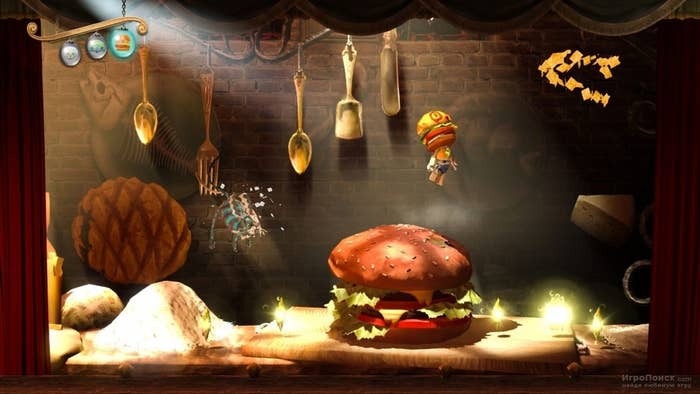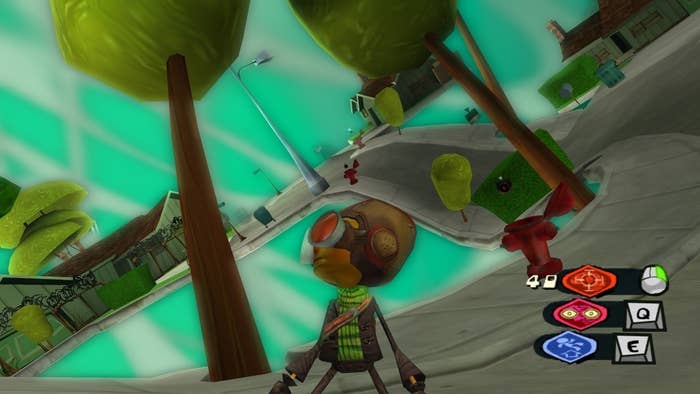
For the second time in as many weeks, a beautiful new platform game came across my desk. Last week it was Rayman Legends; this week it was Puppeteer, by Sony's in-house Japanese development studio. Like Rayman, Puppeteer is a treasure. Both games have a gorgeous and idiosyncratic presentation, a rich and subtle score, a winning sense of humor, and many hours of varied play, all of which bespeak an underlying sense of quality. These are consistent and skillful games that feel personal, authored.
Rayman and Puppeteer have something else in common: They are both flat, set in two dimensions, in the style as old as Donkey Kong. In 2013 that's, obviously, a choice, and both games address that choice—to be flat—through a framing device that is both clever and a little self-conscious. In Rayman Legends, each level of the game is set in one of a row of paintings in a gallery; to start a level you have to literally leap into a flat canvas. In Puppeteer, the entire game is set on a stage, a set of red velvet curtains at the edge of each frame. In the same way a writer of contemporary literary fiction needs a structural reason to employ traditional narrative techniques—a frame narrative, or found text, or something of the sort—to gesture at their own knowingness, these games each seem to say: We know what we're doing is in some ways no different than Super Mario Bros., and we know you know too.
These two games feel in some ways like the AAA capstone to the past five years of platform gaming. Between Nintendo's iterations on the 2D Mario and Donkey Kong games, breakthrough indie platformers like Braid, Limbo and Fez, and hundreds of jumping games good and bad for mobile devices, we are in a stunningly diverse era for 2D platform games.
We are also, concomitantly, a very long way from the golden era of three-dimensional platform games, which was inaugurated by Mario 64 in 1997 and produced such classics as Banjo-Kazooie, Psychonauts, Sonic Adventure, Ratchet and Clank, Conker's Bad Fur Day, Jak and Daxter, and in a limited sense, Crash Bandicoot. Leaving out the Super Mario Galaxy games (and possibly the first Epic Mickey), it is difficult to think of a 3D platformer in the past half-decade that even approaches the polish, quality, and ambition of the aforementioned games.

Why? Well, let's start with the obvious reasons. First, 3D platform games, even at their very best, have never approached the precision in control of 2D games. When the basic gameplay unit of your genre is the jump, that's, obviously, important. Second, 2D games are cheaper and easier to make. When you're a two-man indie studio, that's, obviously, important. Finally, when a developer is designing the setting of a 2D platformer, he or she is only limited, in a certain sense, by his or her imagination, the same as any other artist working on a flat canvas. Building a 3D world has so much more to do with creating a set of physical rules and making them cohere; it is architecture, if you will, and not painting. It is much less painstaking, as a result, to make a 2D game that feels artistic, painterly.
I asked Edmund McMillen, one of the creators of the 2010 Super Meat Boy, one of the new classics of the genre, why 3D platformers have fallen off to such a degree. The answer, he said, is logistics: "Simply, the 3D platformer takes more time, money and people to make than 2D ones, and thats why you see less of them. 3D games require more effort to prototype and make things playable and fun than 2D games." As a genre, the 3D platformer may simply be a financial nonstarter.. From the perspective of a big studio, why pour resources into a 3D platformer when they can be put into a sandbox game or a military first person shooter with the potential to turn enormous profits?
And that, of course, dovetails with trends in the industry: Fewer huge-budget, AAA games that risk failure, more mid-price iterations, downloadable content, and indie games. Of course, that's not necessarily a bad thing. 2D platformers must be one of, if not the best, understood genres in gaming, and their simple grammar and established rules mean there are very few gamers who can't play them.
But I wonder what we've lost in the move away from 3D platforming. While the genre certainly had its tired conventions (endless collectible items, a fixation on the cute and cuddly), it still offered distinct and sometimes indelible pleasures. Who can forget the first time they steered Mario around "Bob-omb Battlefield" or piloted Raz through the Milkman Conspiracy level of Psychonauts? I'm not sure a 2D platformer could ever capture the sense of possibility and scope of the former, or the humor and complex characterization of the latter.
Certainly, there are 3D platformers to come, among them a new Ratchet and Clank and Super Mario 3D World, for the Wii U (though to my eyes this game's ambition, compared to the Galaxy games, seems diminished, and that's putting it kindly). But the energy of the jumping video game, in 2013, is entirely in two dimensions. And after almost two decades of moving in 3D, that can't but feel a little, well, flat.
